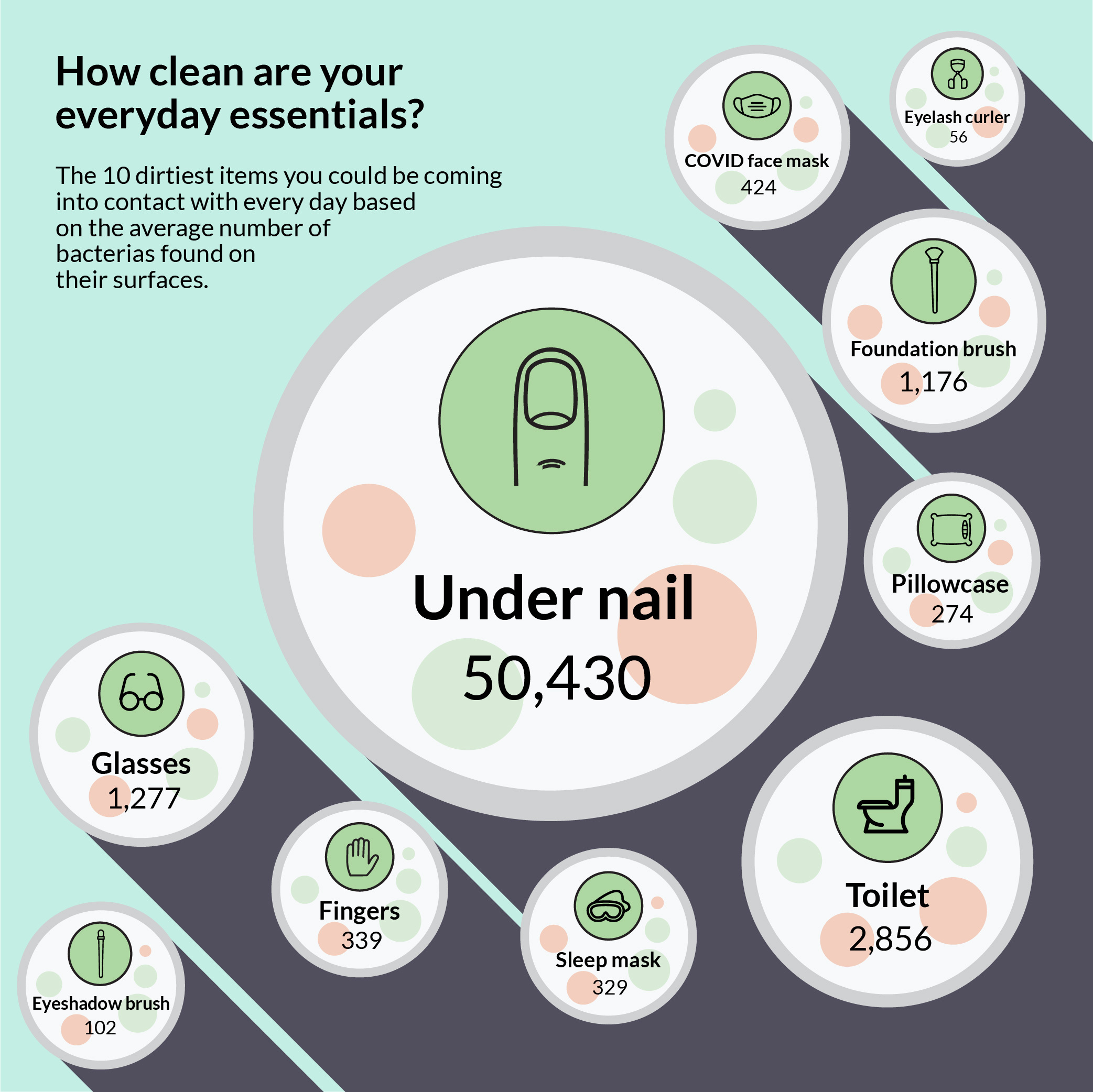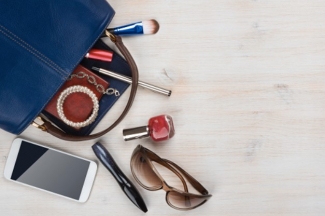How much bacteria is lurking on our everyday essentials?
Maintaining good hygiene has never been more important as we all go to extra lengths to protect ourselves from bacteria and germs. But have you ever wondered what could be lurking on some of your everyday essentials?
From the pillowcase that you sleep on to the glasses you put on your nose, Lenstore has conducted an experiment analysing multiple surfaces of 19 different everyday items to reveal just how much bacteria could be gathering on them.
Taking a look at the results further, expert Contact Lens Optician Sujata Paul has commented on the effects everyday bacteria can have when coming into contact with your eye.

The average number of bacteria found on the following items are:
| Swabbed item | The average number of bacteria found |
| Under nail | 50,430 |
| Toilet | 2,856 |
| Glasses | 1,277 |
| Foundation brush | 1,176 |
| COVID face mask | 424 |
| Fingers | 339 |
| Sleep Mask | 329 |
| Pillowcase | 274 |
| Eyeshadow Brush | 102 |
| Eyelash curler | 56 |
| Mobile | 38 |
| Kitchen Surface | 23 |
| Tube | 19 |
| Mascara | 6 |
Whilst lots of bacteria we find on everyday surfaces can be harmless, some may not be so innocent, making it important to ensure you are keeping to good hygiene with all the surfaces and items you come into contact with on a daily basis.
Our nails have more bacteria than any other surface, including a toilet seat and the London Underground
You may want to think twice before biting your nails with the analysis revealing the bacteria found underneath them comes to a gruesome average of 50,430 per nail. This is a shocking 18 times more than the average toilet seat analysed, which came in second with 2,856 items of live bacteria.
We use our hands for everything, from eating a slice of pizza to chopping meat and veg, and whilst many of us are good at sanitising our hands, we often ignore the area underneath the nail where this bacteria has collected.
Whilst we can’t remove all the germs from our hands and fingernails, it’s important to reduce them as much as possible, with the bacteria found in this area often being connected to vomiting and diarrhoea. Other infections you can get from the bacteria under your fingernail include paronychia and pinworms.
Maintaining good fingernail hygiene includes diligently cleaning and trimming your fingernails on a regular basis, avoiding biting or chewing your nails and ensuring any tools you are using on your nails are sterilised, to avoid the build-up of bacteria and prevent the spread of infection.
Glasses are harbouring some of the most bacteria compared to other everyday items, along with our pillowcases
With almost two million people in the UK living with sight loss, many of us are dependent on our glasses. Throughout the day, without realising, we can find ourselves touching our glasses very often, from taking them on and off for reading, to readjusting them on our faces.
But with glasses coming in as the third dirtiest item in our analysis, just after a toilet seat, with an average of 1,277 items of bacteria, it is worth ensuring you are cleaning them regularly, or switching for a pair of lenses where you won’t need to worry about touching them all the time.
Finally, with sleep being one of the most important and favourite times of the day, there’s nothing more important than getting a relaxing and hygienic routine in place. However, with the results highlighting that on average there are 274 items of bacteria on the fabric we fall asleep onto and 329 inside our sleep masks, we need to be ensuring we are changing these regularly.
Each night your body sheds an average of 15 million skin cells, which means our pillowcases are the perfect environment for dust mites and bed bugs. In addition, unwashed pillowcases can be bad for your skin and can flare up cases of acne, irritation and also any allergies you may have. According to the Sleep Foundation, we should be washing our sheets and pillowcases once per week for hygienic resting.

Our face masks are dirtier than most everyday items including our pillowcase, mobile and even the London Underground tube line!
Wearing a face mask has become the norm since the outbreak of COVID-19, and for many of us, it is a way to help us be more safe and protected from any viruses and bacterias. But have you ever wondered how much bacteria is on the mask you are breathing into?
Analysing five different face masks, the average amount of bacteria on the inside area (the area we breathe into), has an average of 424 bacterias found. With a mobile phone screen having an average of 38, our face masks have over 11 times more bacteria lingering on them.
Whilst face masks are an important way to protect ourselves from COVID-19, we also need to be aware of using them correctly and preventing them from causing other infections. With many masks sitting just under the eyes, bacteria can enter the eyelash follicles and glands along our eyelids, which can cause discomfort, pain and irritation, as well as causing infections such as styes.
Whilst this may come as no surprise with us breathing into our masks, releasing oral and nasal bacterias, it is important to ensure we are washing them regularly to avoid any buildup and taking them off for a break every few hours. It is also advised to avoid touching your face and eyes as much as possible.
Foundation brushes are the dirtiest item in our makeup bag
| Swabbed item | The average number of bacteria found |
| Foundation brush | 1,176 |
| Eyeshadow Brush | 102 |
| Eyelash curler | 56 |
| Mascara | 6 |
Swabbing five different foundation brushes, eyebrow brushes, eyelash curlers and mascara’s, we wanted to find out the makeup items that are harbouring the most bacteria.
The foundation brush comes out on top as the dirtiest makeup product in our bags by far, with an average of 1,176 items of bacteria found on them, which is over 1,000 more than all other beauty items analysed. This brush also comes out as the fourth dirtiest everyday item in the analysis.
Not only can dirty brushes cause irritation and blocked pores, encouraging break-outs on your skin, they can also result in a staph infection, which is caused by a bacteria called staphylococcus. Symptoms of this infection include painful red lumps, sores or blisters, red eyelids and eyes or hot swollen skin. Whilst they can go away on their own, they sometimes need antibiotics and can lead to more serious infections such as blood poisoning if left untreated. If you have a suspected case of blood poisoning, you should consult with your GP immediately.
Since many of us use brushes to apply foundation across our whole face, it’s important to ensure we are regularly cleaning these with some lukewarm water and anti-bacterial cleanser to prevent bacteria from spreading not only across our faces but into our eyes, nose and mouth. Foundation brushes should be cleaned once a week to avoid any build-up of bacteria.
Surprisingly, brushes have come out as far dirtier than makeup itself with our mascara wands being impressively bacteria-free with just six colonies found on average.
Are wipes or cleansers the best way to remove makeup and bacteria from your face?
We also wanted to find out which makeup remover was the most effective for removing bacteria, so we also swabbed different faces of those who remove makeup with a wipe, or with a cleanser and cotton pad.
| Swabbed item | The average number of bacteria found |
| Removal with cleanser | 569 |
| Remover with a wipe | 644 |
Removing makeup and bacteria from your face with a cleanser proves more effective than using a wipe, with the average bacteria found at 569, compared to 644. Bacteria will always be on our faces, and the majority of it is harmless, however, it’s important to ensure you are using the most effective remover to prevent buildup.
Sujata Paul, Professional Services Clinical Lead and Contact Lens Optician FBDO/CL, comments;
‘Bacteria has gained a negative reputation but it is important to remember that not all strains are harmful, with some in fact being beneficial for us. However, with our everyday essentials it is important we are maintaining good hygiene to prevent any irritation to our faces and eyes especially.
For many of us, we do not realise how often we touch our faces and eyes after handling other items and surfaces. However, with makeup brushes, pillowcases and our face masks being covered in bacteria, our eyes are at even greater risk as we often are exposed to direct contact with these items. To avoid a stye, conjunctivitis or any other eye conditions, we need to take extra care of washing our hands and fingernails, as well as the items that come into close contact with these areas.’



